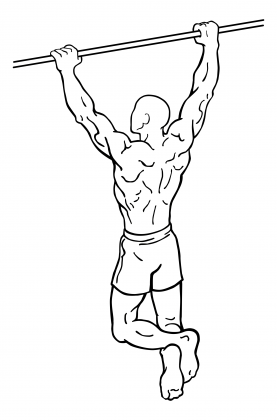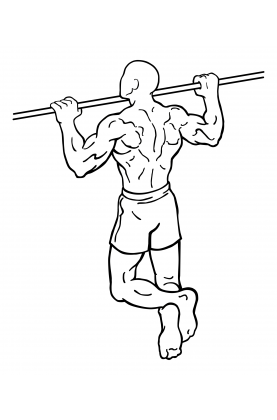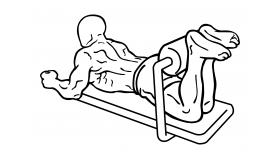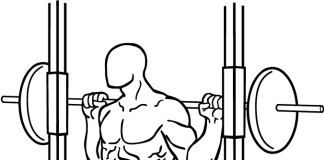Last Updated on September 28, 2014
Pull-ups are a classic and powerful exercise for building upper body strength, particularly targeting the lats (latissimus dorsi), biceps, and middle back muscles. They are a true test of fitness, requiring both strength and technique. Whether you’re a beginner or an advanced athlete, pull-ups can be adapted and mastered to achieve your fitness goals.
This guide provides a comprehensive look at the benefits of pull-ups, step-by-step instructions for perfecting the technique, common mistakes to avoid, and variations to keep your workouts challenging. Let’s explore how to get the most out of pull-ups!
The Benefits of Pull-Ups
Pull-ups are a versatile and effective exercise that delivers numerous benefits:
- Lat Development: Pull-ups primarily target the latissimus dorsi muscles, giving the back a wider and stronger appearance. They help sculpt the V-shape, which many people aim for.
- Bicep Strength: The pulling motion heavily engages the biceps, promoting size and strength gains in the upper arms.
- Middle Back Activation: Pull-ups work the rhomboids and other middle back muscles, enhancing posture and supporting spine health.
- Improved Grip Strength: Holding your body weight while pulling up strengthens the forearms and grip, which is beneficial for other exercises and daily activities.
- Core Engagement: Proper pull-ups also engage the core muscles, providing stability and improving overall body control.
- Functional Fitness: Pull-ups simulate real-life movements, such as pulling yourself up or climbing, making them a functional exercise that enhances overall strength.
How to Perform a Perfect Pull-Up
Executing a proper pull-up requires technique and focus. Follow these steps to ensure you’re maximizing the benefits and minimizing the risk of injury:
- Setup:
- Find a pull-up bar that’s high enough to allow you to hang freely without your feet touching the ground.
- Grab the bar with palms facing forward (overhand grip). The grip width can vary, but a wider grip targets the lats more effectively.
- Starting Position:
- With your arms extended, lean back slightly (around 30 degrees) to create a natural curve in your lower back.
- Stick your chest out and engage your core to stabilize your body. Your legs can be crossed or kept straight, depending on comfort.
- This is your starting position. Your body should remain stationary throughout the movement, and your arms will do most of the work.
- Pulling Up:
- Exhale as you pull your torso upward until your upper chest reaches the bar.
- Focus on drawing your shoulders and upper arms down and back to activate your lats effectively.
- Keep your elbows pointed downwards as you pull, ensuring your upper torso remains stationary and your movement is controlled.
- Contract and Hold:
- Once your upper chest touches the bar, hold the position for a second. Squeeze the lats and middle back muscles to maximize contraction.
- This moment of contraction is crucial for building strength and muscle engagement.
- Lowering Down:
- Inhale as you slowly lower your body back to the starting position.
- Make sure to extend your arms fully, allowing the lats to stretch completely. Maintain control throughout this phase to engage your muscles effectively.
- Repeat:
- Repeat the movement for as many repetitions as you can while maintaining proper form. Aim for 3-4 sets of 5-10 reps, depending on your fitness level.
Common Mistakes to Avoid
Even though pull-ups are a simple movement, they are often performed incorrectly. Here are some common mistakes and how to avoid them:
- Swinging or Kipping:
- Avoid using momentum to pull yourself up. Swinging or kipping takes the focus off your back muscles and increases the risk of injury. Perform each rep slowly and with control.
- Partial Reps:
- It’s essential to complete the full range of motion. Lowering only halfway down limits muscle engagement and reduces the effectiveness of the exercise. Lower until your arms are fully extended.
- Incorrect Grip Width:
- Using a grip that’s too wide or too narrow can strain the shoulders or wrists. For beginners, a shoulder-width grip is ideal. As you progress, you can adjust the width to target different muscles.
- Pulling with Forearms:
- The forearms should only function to grip the bar. The primary pulling force should come from the back and biceps. Focus on engaging the lats as you pull up.
- Hunching Shoulders:
- Many people hunch their shoulders as they pull up. Keep your shoulders down and back to properly engage the lats and prevent shoulder strain.
Pull-Up Variations for All Levels
Pull-ups can be modified or advanced depending on your fitness level. Here are some variations to try:
1. Assisted Pull-Ups (Beginner)
If you’re new to pull-ups, assisted variations can help you build strength gradually.
- Resistance Band Assistance: Loop a resistance band around the bar and place your feet in it. This provides extra support as you pull up.
- Assisted Machine: Many gyms have pull-up machines that counterbalance your weight, making the movement easier.
2. Negative Pull-Ups (Beginner)
Negative pull-ups focus on the lowering phase, which is easier and helps build strength for a full pull-up.
- Jump or use a bench to get into the top pull-up position.
- Slowly lower yourself back down, taking 3-5 seconds to reach the starting position.
- Repeat for several reps to build strength in the lats and biceps.
3. Wide-Grip Pull-Ups (Intermediate)
This variation targets the upper back and lats more intensely.
- Use a wider grip than shoulder-width and perform the pull-up as usual.
- Focus on pulling your chest towards the bar and squeezing your shoulder blades together.
4. Close-Grip Chin-Ups (Intermediate)
Chin-ups, with palms facing towards you, focus more on the biceps while still engaging the back.
- Grab the bar with a close, underhand grip.
- Pull up until your chin is above the bar, keeping your elbows close to your body.
5. Weighted Pull-Ups (Advanced)
Adding weight increases resistance and challenges the muscles further.
- Attach a weight belt or hold a dumbbell between your feet.
- Perform pull-ups as usual, focusing on controlled movements and maintaining proper form.
6. Archer Pull-Ups (Advanced)
Archer pull-ups focus on one side at a time, building unilateral strength and control.
- Start with a wider grip. As you pull up, shift your weight to one side, extending the opposite arm out.
- Alternate sides with each rep to work each side independently.
Pull-Up Challenges for Strength Progression
To improve your pull-up strength, try these progressive challenges:
- Grease the Groove:
- Perform pull-ups multiple times throughout the day, doing 2-3 reps each time. This technique helps build endurance without overfatiguing the muscles.
- Pyramid Training:
- Start with 1 pull-up, rest for 10 seconds, then do 2 pull-ups, rest again, and increase until you reach your maximum. Then work your way back down.
- Time-Based Pull-Up Challenge:
- Set a timer for 5 minutes and perform as many pull-ups as possible within that time. Record your reps and try to increase each week.
Integrating Pull-Ups Into Your Workout Routine
Pull-ups can be a standalone exercise or part of a larger upper body or back workout. Here are ways to incorporate them:
- As a Warm-Up:
- Use pull-ups to activate your back muscles before weight training. 2-3 sets of 5-8 reps will prepare your upper body.
- Back Day Routine:
- Integrate pull-ups into your back workout alongside other exercises like rows and deadlifts for a complete upper body routine.
- Example: 3 sets of pull-ups, 3 sets of bent-over rows, and 3 sets of deadlifts.
- Superset for Upper Body:
- Pair pull-ups with push-ups for a balanced upper body superset.
- Example: Perform 10 pull-ups followed by 15 push-ups, rest for 60 seconds, and repeat for 3 sets.
The Science Behind Pull-Ups
Pull-ups are a compound movement, engaging multiple muscles simultaneously. The primary muscle groups targeted include:
- Latissimus Dorsi: The largest muscle in the back, responsible for pulling the arms downward and backward.
- Biceps Brachii: Activated during the pulling phase, supporting the lats in lifting the body.
- Rhomboids and Trapezius: These muscles stabilize the shoulder blades and engage during the movement, promoting upper back strength.
- Core Muscles: The abs and obliques help stabilize the body, preventing swinging and maintaining form.
By consistently practicing pull-ups and incorporating progressive overload (adding reps, weight, or intensity), you can stimulate muscle growth and strength gains.
Mastering pull-ups is a journey that builds upper body strength, improves posture, and enhances overall fitness. Whether you start with assisted pull-ups or challenge yourself with advanced variations, the key is to maintain consistency and proper form. Pull-ups are not just an exercise; they’re a skill that, when perfected, provides incredible benefits for your physique and strength.








